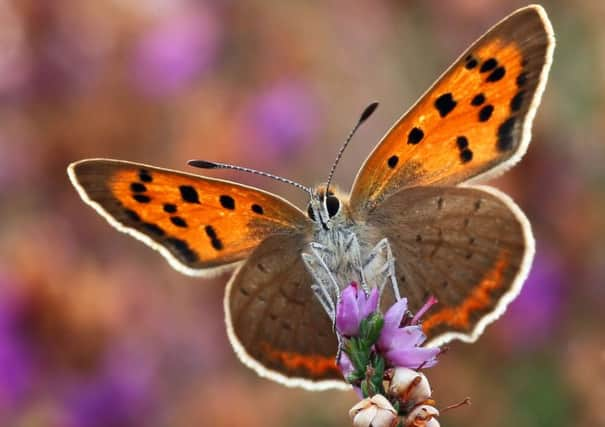Winged wonder: The butterfly is back!


Butterflies are one of the most threatened groups of wildlife but the delicate winged creatures are enjoying something of a revival, much to the delight of conservationists.
Over the last decade nearly 70 butterfly and moth species have become extinct, while two-thirds of species are thought to be in decline and more than 170 species are under threat, the environmental body Butterfly Conservation says.
Advertisement
Hide AdAdvertisement
Hide AdBut the results of its summer-long study are now in and they make for encouraging reading, both nationally and across Yorkshire. In fact, all the signs suggest a revival with numbers up on 12 months earlier.
Butterfly Conservation’s annual Wider Countryside Butterfly Survey (WCBS) assesses the fortunes of common and widespread species by counting farmland butterflies in more than 850 randomly selected 1km-squares across England, Wales, Scotland and Northern Ireland.
Last year recorders saw an average of 85 butterflies of five species per survey made over July and August – almost double the numbers recorded in 2012.
In Yorkshire, the majority of species fared better than in 2012. On average, 81 butterflies of four species were recorded per square compared to 42 butterflies of four species 12 months earlier.
Advertisement
Hide AdAdvertisement
Hide AdSurvey co-ordinator Dr Zoë Randle said some species had really thrived in the region: “Small Tortoiseshell did really well with an average of 19 butterflies being seen per square compared to only five per square in 2012. In one square near Illingworth, 303 Small Tortoiseshells were seen compared to only 20 in the previous year.
“Common Blue also fared well with an average of nine being seen per square in 2013 compared to three in 2012.”
The Yorkshire branch of Butterfly Conservation consists of 1,000 members who work with landowners to ensure butterfly-friendly habitats such as hedgerows and field margins are maintained.
Paul Davis, the group’s treasurer, said: “Last year was an absolute joy and it’s attributable to nature. To see the likes of the Common Blue make a comeback after almost disappearing because of three years of bad weather - it’s just been incredible - and every Butterfly Conservation branch can’t believe how quickly populations have come back to some sort of normal level.”
Advertisement
Hide AdAdvertisement
Hide AdHe said Butterfly Conservation has thrown a lot of resources into reviving the fortunes of struggling species in the North York Moors such as the Pearl-boarded Fritillary and the Burgundy Fritillary.
“It’s a matter of trying to make sure that there is a network of habitats for them to thrive with little links between them so we have been talking to local landowners to try to make sure they are happy to work with us to make sure, for example, that vegetation remains at a certain height.”
He is optimistic that local butterfly populations will remain healthy. “The rain will have washed out butterfly pupa and larvae, and numbers will be down a little this year but the situation is not all that bad considering the recent winters we have had these last few years.”
There are measures anyone with a garden can do to promote the survival of native butterfly species, he said.
Advertisement
Hide AdAdvertisement
Hide Ad“It’s a matter of what we are growing in our gardens. Stop concreting driveways and let’s grow plants that they like - bright, nectar-rich plants.”
In total, the WCBS recorded 5,851 butterflies of 27 species, up from 2,495 butterflies of 23 species in 2012, with typical farmland species such as the Brimstone, Common Blue, Small Copper, Small Skipper, Large Skipper and Small Tortoiseshell all bouncing back.
Top of the species
King of the butterflies in Yorkshire is the Small White, a strong-flying species with striking white wings and small black tips to the forewings with one of two spots.
The undersides of its wings are creamy white and its wing span is typically 48mm. It was identified in 97.22% of squares in Yorkshire as part of Butterfly Conservation’s Wider Countryside Butterfly Survey (WCBS) and consisted of 21.3% of all butterflies counted in the region.
Advertisement
Hide AdAdvertisement
Hide AdThe other most abundant species are: Ringlet, which accounted for 16.7% of all butterflies recorded, Meadow Brown (14%), Small Tortoiseshell (10.5%) and Green-veined White (9.6%).
Survey co-ordinator Dr Zoë Randle said: “Farmland butterflies really thrived last year primarily due to the fantastic summer weather which provided ideal conditions with several recording their best ever WCBS results.”